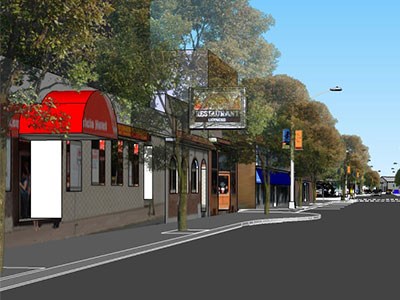Kenora's downtown revitalization efforts are shifting into third gear.
With two rounds of construction under its belt, Kenora's version of the Big Dig will be moving off its scenic waterfront and is heading uptown.
Beginning in 2008, Kenora spent $25 million for its two-phase Big Spruce project that first dug up and improved Main Street before fixing up the harbourfront with better pedestrian access, a concert and festival venue, and new marina docks.
Now Second Street, a major artery through this lakeside town, is in for the same treatment.
After the local forestry industry took a pounding in the 2000s, the northwestern Ontario community of 15,000 decided to turn on the Victorian charm in its downtown core by boosting its already-thriving tourism and cottage economy.
The City of Kenora has earmarked up to $2 million towards construction on Second Street that's estimated to be in the $6 million range once detailed design work is finished this fall. Once the project goes to tender, various government funders are expected to kick in some money.
Groundbreaking begins sometime during the 2014 summer construction season. The upcoming work will be similar to Main Street in replacing century-old sewer and water works, installing new curbs and sidewalks, new street paving, and adding historic streetlights along with a storefront facade improvement program.
“As much as we see the streetscaping at the end, what drives the agenda is certainly the underground,” said Jennifer Findlay, Kenora's economic development officer. While the Main Street construction caused plenty of headaches for shopowners during the height of the tourism season, Finley expects less apprehension next year now that everyone has witnessed the improvements.
“Unfortunately in Canada the construction and busy season coincide.” Business owners will serve as “block captains” to help direct the staging and timing of construction schedule to minimize any negative impacts.
Handling the design work is Winnipeg's Hilderman Thomas Frank and Cram, which handled the two previous phases, and Hatch Mott MacDonald of Thunder Bay are the project engineers.
“We've met with each business interested in partnering with us to do some landscaping and street planting to coordinate the look and feel as you go down the street,” said Findlay.
“What we're finding with Second Street is that it is already a dynamically growing business street.” One new business coming to Second is a microbrewery that's moved into a former city fire hall. Three years ago, Taras Manzie, the owner of a local inn and bistro, spent more than $2 million to acquire and renovate the 100-year-old landmark into a licensed 300-seat brew pub.
Branded as the Lake of the Woods Brewing Company, he was scheduled to open at the end of June.
The business revives the name of an historic brewing company dating back to the early 1900s. The 50- employee operation will run year-round.
“We're going to have a terrific venue for people to come and enjoy,” said Manzie. “We'll carry our own beer on tap and we have a great deal of interest within the region and we're a short two hours away from 800,000 people in Winnipeg.
“A lot of Manitobans come to Lake of the Woods; we're kind of the northern Muskokas, it's cottage country and a lot of brand recognition to go with it.”
The building was gutted and he installed a gas-fired commercial kitchen, walk-in cooler and all new electrical, heating and air conditioning systems.
The main floor will house a restaurant, tap room, retail store, and a packaging and distribution centre to sell beer to other bars and restaurants.
The second floor features a lounge with pool tables, dart board and private meeting space. The 10- ectoliter brew system was shipped over from Asia.
Manzie said it's difficult to find good used equipment because of the explosion in the North American microbrewing industry.
“We were in the pipeline to get new equipment made out west (in Richmond B.C.) but would have extended our opening timelines by six or eight months.
“Before we were about to sign that contract we found a broker who found a system that was about to be decommissioned in South Korea and it's German-made by Kaspar Schultz, who've been making brewing systems for 600 years.”
Manzie purchased the plant sight unseen and had the plant, worth about US $210,000, disassembled and containered to Kenora.
“We took a bit of a risk as we're doing in building this business. Sometimes you just gotta take a gamble and play your cards.”




